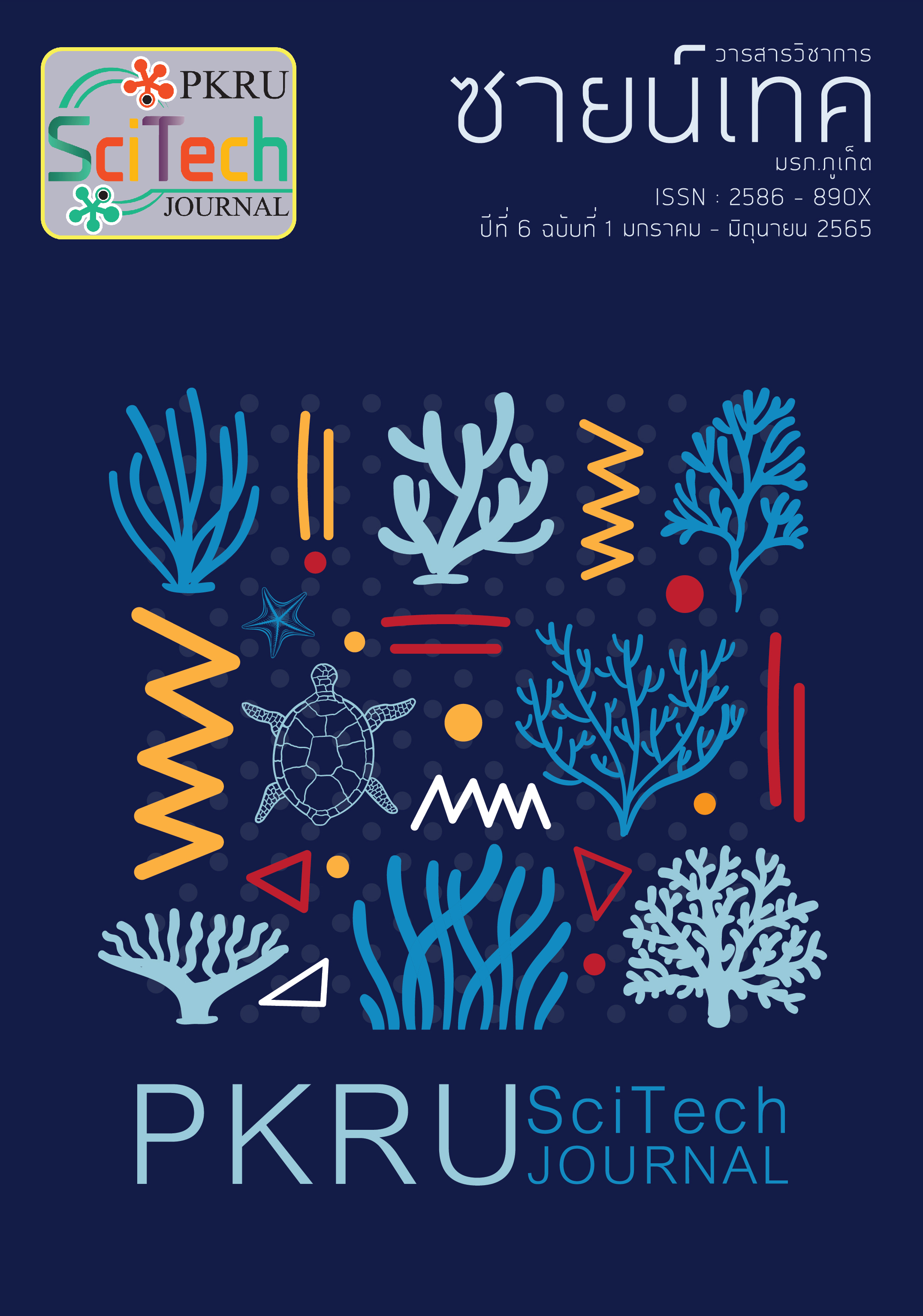ฟีนอลิกรวม ฤทธิ์ต้านออกซิเดชัน ฤทธิ์ต้านไทโรซิเนส ฤทธิ์ต้านคอลลาจิเนส และฤทธิ์กระตุ้นการแบ่งเซลล์ของสารสกัดผลดิบสตาร์แอปเปิ้ล
Main Article Content
บทคัดย่อ
สตาร์แอปเปิ้ล (Chrysophyllum cainito L.) หรือต้นน้ำนม เป็นไม้ยืนต้นที่ผลกินได้ มีสรรพคุณทางยาหลายประการ เช่น ต้านเบาหวานและต้านการอักเสบ สารออกฤทธิ์ที่สำคัญในสตาร์แอปเปิ้ลเป็นสารประเภทฟลาโวนอยด์ ซึ่งมีฤทธิ์ทางชีวภาพในการต้านออกซิเดชัน ต้านมะเร็ง และต้านการอักเสบ งานวิจัยนี้มีวัตถุประสงค์เพื่อประเมินฤทธิ์ทางชีวภาพของสารสกัดหยาบเอทานอลและส่วนย่อย (CCF1-CCF4) จากผลดิบสตาร์แอปเปิ้ลเพื่อประยุกต์ใช้ในผลิตภัณฑ์เครื่องสำอาง ซึ่งผลการทดสอบพบว่า สารสกัดหยาบมีปริมาณฟีนอลิกรวม เท่ากับ 0.34±0.01 มิลลิกรัมสมมูลของกรดแกลลิกต่อสารสกัด 1 มิลลิลิตร ซึ่งด้อยกว่าส่วนย่อย CCF4 (0.41±0.01 มิลลิกรัมสมมูลของกรดแกลลิกต่อสารสกัด 1 มิลลิลิตร) เล็กน้อย ที่ความเข้มข้นเริ่มต้น 5 มิลลิกรัมต่อมิลลิลิตร ส่วนย่อย CCF4 แสดงฤทธิ์ต้านอนุมูลอิสระ DPPH ได้ดีที่สุด (0.3±0.00 มิลลิกรัมสมมูลของกรดแอสคอร์บิกต่อสารสกัด 1 มิลลิลิตร) และยังสามารถรีดิวซ์เฟอริกได้ดีที่สุด (FRAP value 1.01±0.03 มิลลิกรัมสมมูลของกรดแอสคอร์บิกต่อสารสกัด 1 มิลลิลิตร) ส่วนย่อย CCF4 สามารถยับยั้งไทโรซิเนสได้ 51.82% และที่ความเข้มข้นในถาดหลุม 50 ไมโครกรัมต่อมิลลิลิตร ส่วนย่อย CCF4 แสดงฤทธิ์ยับยั้งคอลลาจิเนสได้ 37.45% และมีฤทธิ์กระตุ้นการแบ่งเซลล์ 15.06% ผลการศึกษาบ่งชี้ว่าส่วนย่อย CCF4 มีสารออกฤทธิ์ที่ดีเป็นองค์ประกอบ เหมาะที่จะนำไปพัฒนาเพื่อนำไปใช้เป็นส่วนผสมในเครื่องสำอาง
Article Details

อนุญาตภายใต้เงื่อนไข Creative Commons Attribution-NonCommercial-NoDerivatives 4.0 International License.
- เนื้อหาต้นฉบับที่ปรากฏในวารสารเป็นความรับผิดชอบของผู้เขียน ทั้งนี้ไม่รวมความผิดพลาดอันเกิดจากเทคนิคการพิมพ์
- ลิขสิทธิ์ต้นฉบับที่ได้รับการตีพิมพ์ในวารสารวิชาการ ซายน์เทค มรภ.ภูเก็ต ถือเป็นกรรมสิทธิ์ของวารสารวิชาการ ซายน์เทค มรภ.ภูเก็ต
เอกสารอ้างอิง
Ebanks, J. P., Wickett, R. R., & Boissy, R. E. (2009). Mechanisms regulating skin pigmentation: The rise and fall of complexion coloration. International Journal of Molecular Sciences, 10(9), 4066-4087.
Fisher, G. J., Varani J., & Voorhees, J. J. (2008). Looking older: fibroblast collapse and therapeutic implications. Archives of Dermatology, 144(5), 666-672.
Luo, X. D., Basile, M. J., & Kennelly, E. J. (2002). Polyphenolic antioxidants from the fruits of Chrysophyllum cainito L. (Star apple). Journal of Agricultural and Food Chemistry, 50, 1379-1382.
Moo-Huchin, V. M., Moo-Huchin, M. I., Estrada-Leon, R. J., Cuevas-Glory, L., Estrada-Mota, I. A., Oritz-Vazques, E., Betancur-Ancona, D., & Sauri-Duch, E. (2015). Antioxidant compounds, antioxidant activity and phenolic content in peel from three tropical fruits from Yucatan, Mexico. Food Chemistry, 166, 17-22.
Vichit, W., & Saewan, N. (2015). Antioxidant activities and cytotoxicity of Thai pigmented rice. International Journal of Pharmacy and Pharmaceutical Sciences, 7(7), 329-334.
Nurrochmad, A., Dirman, W. A., Lukitaningsih, E., Rahmawati, A., & Fakhrudin, N. (2018). Effects of antioxidant, anti-collagenase, anti-elastase, anti-tyrosinase of the extract and fraction from Turbinaria decurrens Bory. Indonesian Journal of Pharmacy, 29(4), 188-197.
Vichit, W., & Saewan, N. (2016). Effect of germination on antioxidant, anti-inflammatory and keratinocyte proliferation of rice. International Food Research Journal, 23(5), 2006-2015.
Kubola, J., Siriamornpun, S., & Meeso, N. (2011). Phytochemicals, vitamin C and sugar content of Thai wild fruits. Food Chemistry, 126(3), 972-981.
Madhan, B., Krishnamoorthy, G., Rao, J. R., & Nair, B. U. (2007). Role of green tea polyphenols in the inhibition of collagenolytic activity by collagenase. International Journal of Biological Macromolecules, 41(1), 16-22.
Malešev, D., & Kuntić, V. (2007). Investigation of metal-flavonoid chelates and the determination of flavonoids via metal-flavonoid complexing reactions. Journal of the Serbian Chemical Society, 72(10), 921-939.


